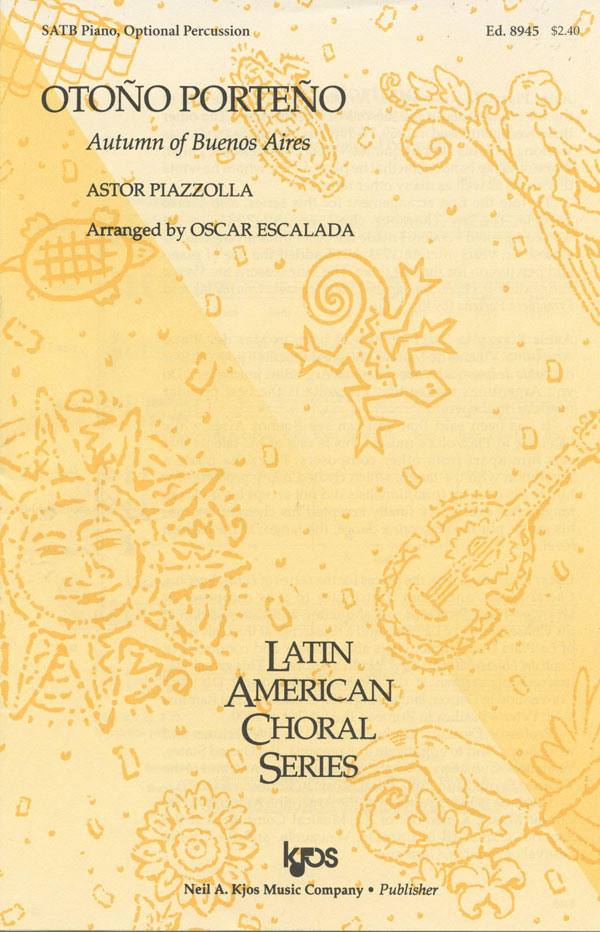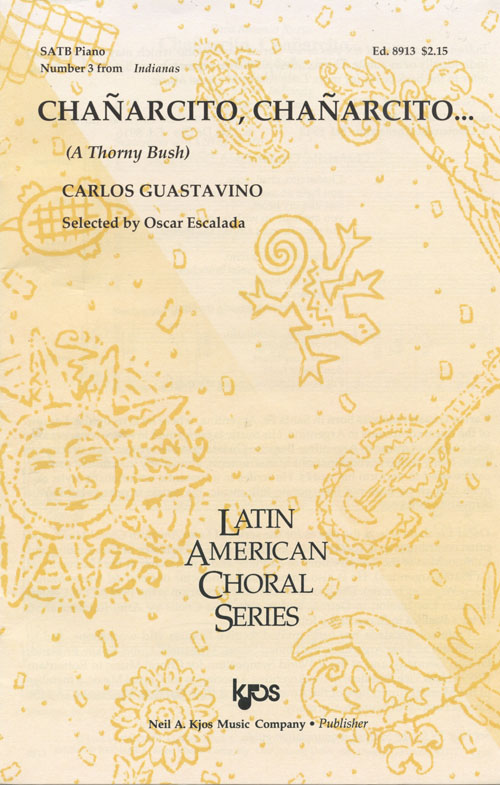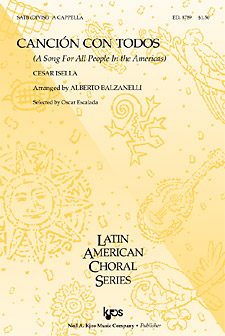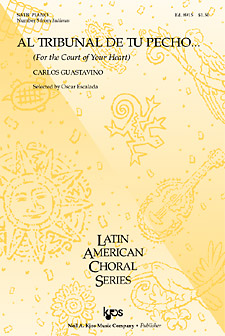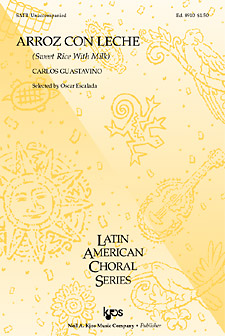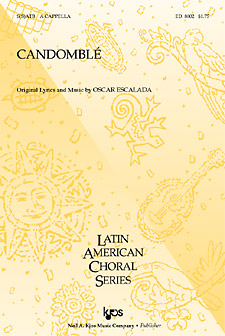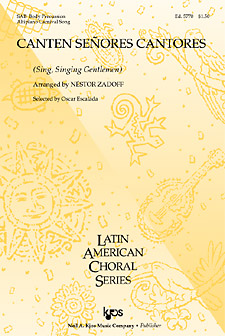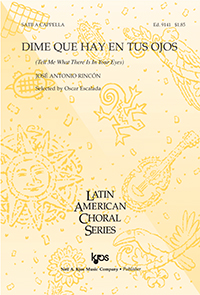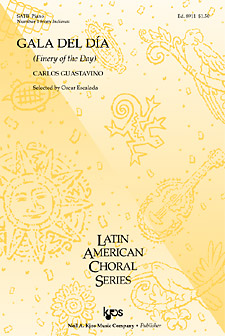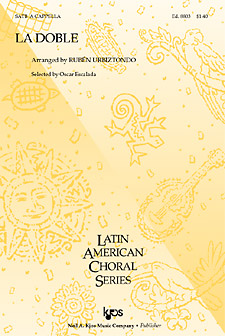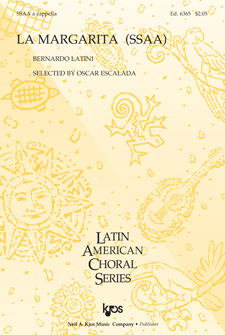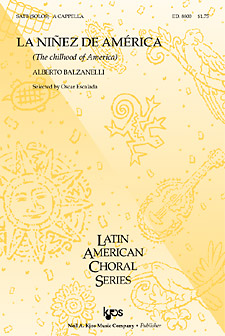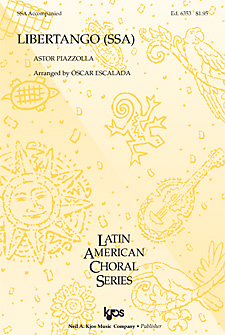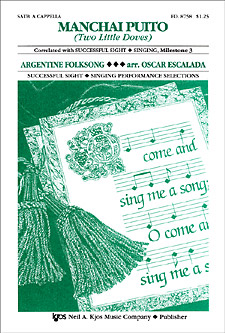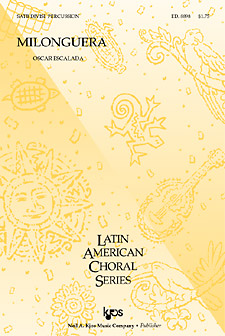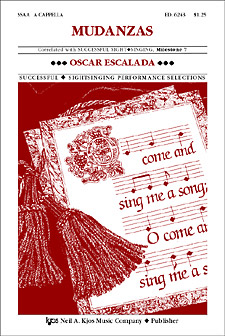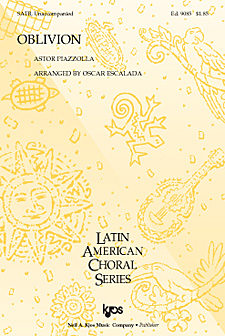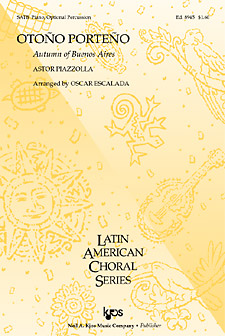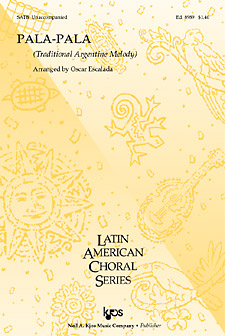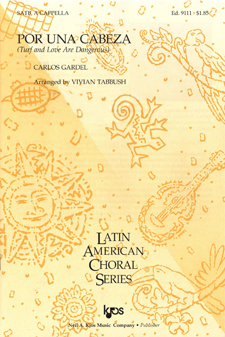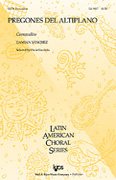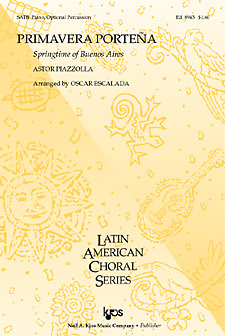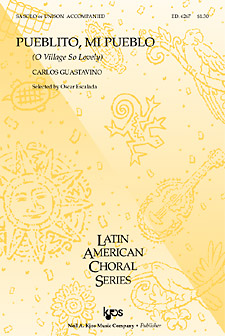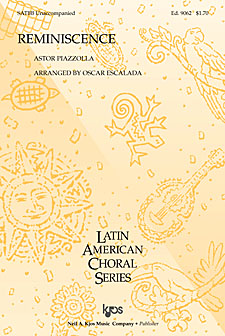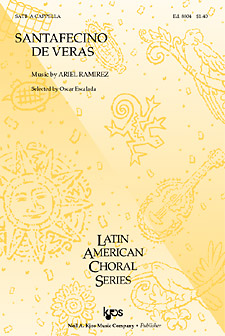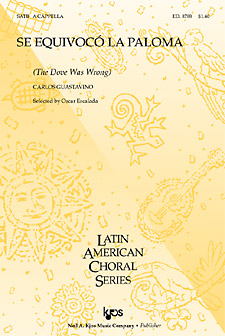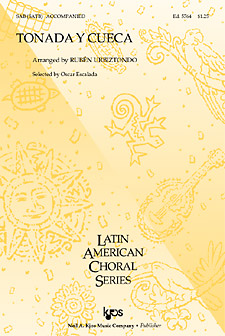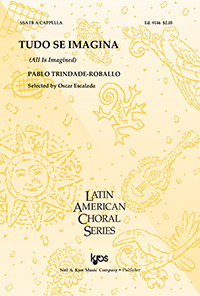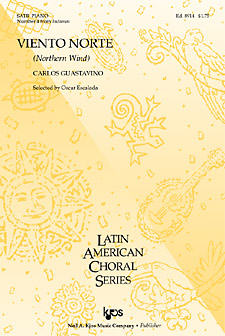In Celebration of the Human Voice - The Essential Musical Instrument
Home | Doo Wop | Barbershop | World | Contemporary | Christian | Vocal Jazz | Choral | Christmas | Instructional | Arrangements
Classical | Opera | Musicals | Personality | Young Singers | Disney | Videos | Songs | The Artists

Choral Arrangements from Argentina
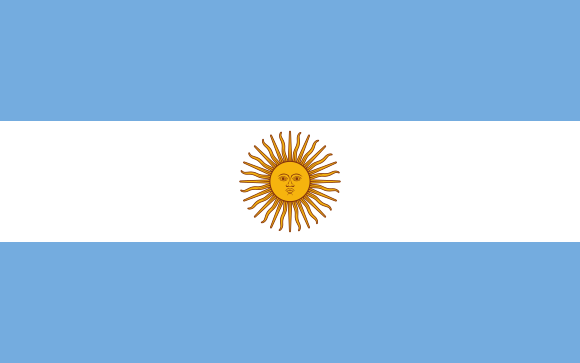
| Traditional and modern Argentinian choral and folksongs arranged for harmony voices. |
![]() Arrangements from Latin America - Argentina | Bolivia | Brazil | Chile | Columbia | Guatemala | Latin America | Mexico | Peru | Uruguay | Venezuela
Arrangements from Latin America - Argentina | Bolivia | Brazil | Chile | Columbia | Guatemala | Latin America | Mexico | Peru | Uruguay | Venezuela
Songbooks, Arrangements and/or Media
Displaying 1-3 of 3 items.
Astor Piazzolla : Tangos in Vocal Harmony It has been said that you can see Buenos Aires while listening to Astor Piazzolla's music. This is one of his talents that sets him apart from other composers. Piazzolla made a revolution with the tango, which created many problems for him in his country (traditionalists did not accept his music as tango). But everybody finally accepted his changes because his music put the Argentine dance, the tango, at the highest level. Gentle tango rhythms and modern harmonies infuse these folk-like tunes. Songlist: Verano Porteno, Libertango, Primavera Poertena, Invierno Poerteno, Otono Porteno, Reminiscense Carlos Guastavino : Indianas Carlos Guastavino writes in a romantic-nationalistic style, and even though he does not incorporate folk music, his music is permeated by the Argentine influence. These intriguing pieces can be performed individually or as a suite. Songlist: Gala del Dia, Quien Fuera Como el Jazmin, Chanarcito, Chanarcito, Viento Norte, Al Tribunal de Tu Pecho, Una de Dos Oscar Escalada : Latin American Choral Series A wonderful collection of contemporary Latin American choral music selected by noted Argintian conductor and composer Oscar Escalada. "La Chaparrita " is a brisk Venezuelan folk melody and is fun to sing and includes the vocal imitation of a typical pattern played on a "cuarto". "Candomble", from Uruguay, is written in a rhythm very close to the tango and the habanera. "La Ninez De America" is based on a poem of Argentinian poet Alberto del Carril and is inspired by the Incas. "Cancion Con Todos " is a two-part song based on two different rhythms. The first part is calm and recognizes each area of the Americas with characteristic elements such as copper for Chile, sun for Peru etc. The second part is rhythmic and exultant with the hope of bringing all the peoples of Latin America to sing together! Songlist: La Chaparrita, Candomble, Cancion Con Todos, Se Equivoco La Paloma (The Dove Was Wrong), La Ninez De America |
Displaying 1-40 of 40 items.
Al Tribunal de Tu Pecho (For the Court of Your Heart) is No. 5 of the Indianas suite by Carlos Guastavino, which may be performed individually or as a suite.
Country: Argentina
Here is a delightful song pairing that will delight every audience and be an excellent concert/festival selection for younger choirs! The folksong comes from Argentina and is sung throughout Mexico, South and Central America. Woven into the arrangement is Estrellita oDondé Estás?, the Spanish version of Twinkle, Twinkle, Little Star, which may also be sung in English. A great bilingual feature!
Arranger: Emily Crocker | Country: Argentina
Arroz Con Leche is based on a melody that Carlos Guastavino learned from his mother. It is a traditional children's round which is very popular in South America. A few small differences in the words occur in some countries. For instance, in Venezuela it is known as "rice with coconut" instead of with milk.
Country: Argentina
Cancion con Todos (A Song for All People in the Americas) is a two-part song based on two different rhythms. The first part is calm and recognizes each area of the Americas with characteristic elements such as copper for Chile, sun for Peru, etc. The second part is rhythmic and exultant. It invites all of the Americas' people to sing together as a family. The hope is to develop a mutual understanding among Latin American people and invite them all to sing together in one huge chorus.
Arranger: Cesar Isalla | Composer: Oscar Escalada | Country: Argentina
Candomble is written in a rhythm very close to the tango and the habanera. Some Latin American music has been influenced by or developed from African rhythms, as in this piece. Candomble is a dance from the Rio de la Plata; now it is heard in Uruguay, where they usually play it with drums of different sizes. This dance was known in Argentina, where it was also called Candomble.
Arranger: Oscar Escalada | Composer: Oscar Escalada | Country: Argentina
A vivacious arrangement of a popular Altiplano Carnival Song and Dance: Sing, Singing Gentlemen! Body percussion infuses even more energy into this SAB voting. Choirs of any age will fall in love with this score instantly!
Country: Argentina
Chanarcito, Chanarcito (A Thorny Bush) is No. 3 of the Indianas suite by Carlos Guastavino, which may be performed individually or as a suite. Carlos Guastavino writes in a romantic-nationalistic style, and even though he does not incorporate folk music, his music is permeated by the Argentine influence.
Country: Argentina
Dr. Cristian Grases of USC is a native of Argentina. He is the editor of a new series with Gentry called The Choral Music of Latin America and the Caribbean, and it is proving to be a delightful collection of Latin gems. This piece begins with tension and disharmony but breaks into soothing chords, lush and full of consolation. The Latin text honors the noble wood of the cross on which Christ was crucified.
Composer: Cesar Alejandro Carillo | Country: Argentina
This Argentinian worship song pulses with rhythmic energy! Perfect for either a first-time world music experience or a full-fledged Latin styled performance. With piano.
Arranger: Roger Bergs | Country: Argentina
Gala del Dia (Finery of the Day) is No. 1 of the Indianas suite by Carlos Guastavino, which may be performed individually or as a suite. Carlos Guastavino writes in a romantic-nationalistic style, and even though he does not incorporate folk music, his music is permeated by the Argentine influence.
Country: Argentina
This exciting work is based on two sources: a traditional Spanish song and a traditional Creole-Argentenian song. The opening has a slow tempo and wimple rhythms, followed by a lively, celebrative dance. The percussion builds throughout, beginning with a triangle and tom-tom, then adds tambourine, and ends with everybody's favorite - the vibraslap.
Arranger: Oscar Escalada | Country: Argentina
It has been said that you can see Buenos Aires while listening to Astor Piazzolla's music. This is one of his talents that sets him apart from other composers. Piazzolla made a revolution with the tango, which created many problems for him in his country (traditionalists did not accept his music as tango). But everybody finally accepted his changes because his music put the Argentine dance, the tango, at the highest level.
Arranger: Oscar Escalada | Composer: Astor Piazzolla | Country: Argentina
A chacarera is a very joyful dance from the Province of Santiago del Estero (northwestern part of Argentina). Separate couples dance with their hands up, making "castanets" with their fingers. Between the first and second verses and again between the second and third verses, there is an instrumental interlude called vuelta, which means "round." At this time the dancers make a round in a circle and then back to their original places.
Arranger: Ruben Urbiztondo | Country: Argentina
A chacarera is a very joyful dance from the Province of Santiago del Estero (northwestern part of Argentina). Separate couples dance with their hands up, making "castanets" with their fingers. Between the first and second verses and again between the second and third verses, there is an instrumental interlude called vuelta, which means "round." At this time the dancers make a round in a circle and then back to their original places.
Arranger: Ruben Urbiztondo | Country: Argentina
Bernardo Latini is one of Argentina's brightest young composers of choral music. "La Margarita" is a new piece for women's choir or children's choir, which tells the story of a poor girl who lives a hard life on the street, but who finds joy in the game of hopscotch. Young singers will enjoy the optional movements that depict the jumps made by the players on a hopscotch square.
Composer: Bernardo Latini | Country: Argentina
The lyrics in La Ninez de America (The Childhood of America) are from a poem written by Bonifacio del Carril, an Argentinean poet who lived 1911-1994. Alberto Balzanelli took the idea for his composition from the music of the Incas, once one of the biggest empires in South America.
Arranger: Alberto Balzanelli | Composer: Oscar Escalada | Country: Argentina
The highly anticipated treble arrangement! Astor Piazzolla is known around the world for his creative works incorporating the traditional sounds and rhythms of the Argentinian tango. Oscar Escalada masterfully uses nonsense syllables to give singers the opportunity to lend their voices to this delightful work. A guaranteed audience pleaser!
Arranger: Oscar Escalada | Composer: Astor Piazzolla | Country: Argentina
Manchai Puito ( Two Little Doves) is a quichua (Indian) folksong from the rural part of Argentina near the Andes mountains. It is somewhat like the gaucho folksongs. The gauchos were of mixed Spanish and Indian heritage. They worked as cattle herders and are still celebrated by stories and songs because they were the heroes of the Pampas, the grassy plains around Buenos Aires. Gauchos were very honest and independent men. Like the cowboys of North America, a gaucho would sing to keep himself company as he worked alone on the plains. He would wear a fringed poncho, bombachas (baggy pants), a belt ornamented with silver coins, leather boots, and spurs.
Arranger: Oscar Escalada | Country: Argentina
Milonguera comes from the word milonga, which is a rhythm very close to the tango. The area of the milonga is Buenos Aires, Argentina. Oscar Escalda has built this exuberant work on a rhythmic pattern and its variations. The words are phenomes (nonsense words) created to get just the right effect with the rhythms.
Arranger: Oscar Escalada | Country: Argentina
The malambo is an Argentinean gaucho dance. It is performed only by men. The gauchos were of mixed Spanish and Indian heritage. They worked as cattle herders and are still celebrated by stories and songs because they were the heroes of the Pampas, the grassy plains around Buenos Aires. Gauchos were very honest and independent men. The two dancers perform a kind of fight: the first dancer "draws" a figure with his feet that must be repeated by the second one. When it is the second dancer's turn, he will draw another figure which must be duplicated by the first dancer. The figures are called mudanzas. The dance is over when one of the dancers cannot repeat the drawing of the other or cannot think of a new drawing.
Arranger: Oscar Escalada | Country: Argentina
The malambo is an Argentinean gaucho dance. It is performed only by men. The gauchos were of mixed Spanish and Indian heritage. They worked as cattle herders and are still celebrated by stories and songs because they were the heroes of the Pampas, the grassy plains around Buenos Aires. Gauchos were very honest and independent men. The two dancers perform a kind of fight: the first dancer "draws" a figure with his feet that must be repeated by the second one. When it is the second dancer's turn, he will draw another figure which must be duplicated by the first dancer. The figures are called mudanzas. The dance is over when one of the dancers cannot repeat the drawing of the other or cannot think of a new drawing. Also arranged for SSAA A Cappella
Arranger: Oscar Escalada | Country: Argentina
The title comes from the Latin oblivio/oblivium meaning "to forget," or better, "the condition of being forgotten, unknown." Astor Piazzolla's (Argentinian) music, originally written for instrumental ensemble, perfectly depicts this rather melancholy mood. Using carefully selected nonsense syllables, this skilled arranger has given advanced high school, college, and community choirs the opportunity to include this much-loved music in their performances. Choirs will love performing (and rehearsing!) this one.
Composer: Astor Piazzolla | Country: Argentina
It has been said that you can see Buenos Aires while listening to Astor Piazzolla's music. This is one of his talents that sets him apart from other composers. Piazzolla made a revolution with the tango, which created many problems for him in his country (traditionalists did not accept his music as tango). But everybody finally accepted his changes because his music put the Argentine dance, the tango, at the highest level.
Arranger: Oscar Escalada | Composer: Astor Piazzolla | Country: Argentina
Pala-pala (Raven) is a joyful song that is most fun when the singers (or dancers) make movements to fit the words, including pala-pala (raven), chuna (wading bird), and ampatu (toad). For instance, for the raven, dancers would move their arms and heads to imitate the wings of the raven.
Arranger: Oscar Escalada | Country: Argentina
Dr. Cristian Grases of USC is a native of Argentina. He is the editor of a new series with Gentry called The Choral Music of Latin America and the Caribbean, and it is proving to be a delightful collection of Latin gems. The meter changes are plentiful and the music dances along playfully, and we are rewarded with a contemporary madrigal that is undeniably Latin in flavor.
Composer: Jose Mena | Country: Argentina
Singer, songwriter and actor Carlos Gardel was born in France, but moved to Argentina at age 2. He was instrumental in popularizing the Argentine tango and rose to legendary fame in the late 1920's and early 1930's in Argentina and throughout Latinĺ America. Tragically, Gardel ded in 1935 in an airplane crash in Medellin, Colombia, in which his friend and lyricist Alfredo Le Pera also was killed. It is well known that Gardel was a horse racing amateur, and so it is not unusual that in his compositions he frequently refereed to jockeys and horses. The Argentine tango "Por Una Cabeza" (By Just One Head) was composed for Gardel's last film, Tango Bar (1935), and was used more recently in the American film Scent of a Woman (1992) starring Al Pacino. In this tango, love and women are compared to the dangerous chance of a horse race, where luck is often elusive. Hence, the sub-title "Turf and Love are Dangerous."
Arranger: Vivian Tabbush | Country: Argentina
Pregones del Altiplano (common cries from the Andean mesas) uses the carnavalito rhythm of a very common dance in an area called Altiplano. The Altiplano is in the northern part of Argentina and Bolivia, south of Peru, and north of Chile. It has recently been designated Patrinoio de la Humanidad because of its tradition and aborigine heritage.
Arranger: Oscar Escalada | Country: Argentina
It has been said that you can see Buenos Aires while listening to Astor Piazzolla's music. This is one of his talents that sets him apart from other composers. Piazzolla made a revolution with the tango, which created many problems for him in his country (traditionalists did not accept his music as tango). But everybody finally accepted his changes because his music put the Argentine dance, the tango, at the highest level.
Arranger: Oscar Escalada | Composer: Astor Piazzolla | Country: Argentina
Pueblito mi pueblo (O Village So Lovely) is a warm and elegant melody for unison, solo voice, or two parts with solo. Guastavino has cleverly given each part a nice melody, even though one is the main melody and the other is accompaniment.
Country: Argentina
Quien Fuera Como El Jazmin (Who Could Be Like the Jasmine) is No. 2 of the Indianas suite by Carlos Guastavino, which may be performed individually or as a suite. Carlos Guastavino writes in a romantic-nationalistic style, and even though he does not incorporate folk music, his music is permeated by the Argentine influence.
Country: Argentina
Gentle tango rhythms and modern harmonies infuse this folk-like tune. Sopranos carry the melody while Basses emulate rich pizzicatos, providing a deliberate, forward motion. Altos and Tenors fill out the texture, evoking sounds of bowed strings, the bandoneon, and the guitar. Lyrics are simple, easy to learn syllables; rhythms are straightforward, with a clear pulse. A great choice for introducing your choir to Latin American music!
Arranger: Oscar Escalada | Country: Argentina
Santafecino de versa is a chamame, a people's joyful dance from the eastern part of Argentina, an area called Litoral. The dancers put their cheeks together, looking at the same side. They take each other's hands extended ahead, and they dance together with an up and down movement, as if they were jumping. Sometimes they like to shout in a very high tune, which called sapucay, a Guarani language word.
Arranger: Oscar Escalada | Country: Argentina
Santafecino de versa is a chamame, a people's joyful dance from the eastern part of Argentina, an area called Litoral. The dancers put their cheeks together, looking at the same side. They take each other's hands extended ahead, and they dance together with an up and down movement, as if they were jumping. Sometimes they like to shout in a very high tune, which called sapucay, a Guarani language word.
Arranger: Oscar Escalada | Country: Argentina
Rafael Alberti is one of the great Spanish poets of the 20th Century. A few years after publishing the poem, Se equivoco la paloma (The Dove Was Wrong), Alberti was visited by a young Argentine composer who asked for permission to use the poem in a song. Alberti had never thought that his poem would become such a great success as it has. The young composer was indeed Carlos Guastavino. The song is a wonderful blend between the lyrics and the music. Guastavino musically describes the great tenderness of the dove that missed the way, but leaves to your imagination any kind of interpretation that you would like to make of this beautiful poem.
Arranger: Carlos Guastavino | Composer: Oscar Escalada | Country: Argentina
Tonada is a slow piece and is usually used in love songs, just as it is used in this case. Cueca is a very rhythmic and joyful dance. Both of these pieces are from the Andes area, in a region called "Cuyo," specifically from the Province of Mendoza in the western part of Argentina.
Arranger: Ruben Urbiztondo | Country: Argentina
Una de Dos (One Or the Other) is No. 6 of the Indianas suite by Carlos Guastavino, which may be performed individually or as a suite. Carlos Guastavino writes in a romantic-nationalistic style, and even though he does not incorporate folk music, his music is permeated by the Argentine influence.
Country: Argentina
Diana Saez is a specialist in the field of Latin American music and one of America's finest arrangers of Latin American Folk music. This arrangement for SA choir and piano with optional guitar is a beautiful and simple setting of a northern Argentinian folk melody.
Arranger: Diana Saez | Country: Argentina
Viento Norte (Northern Wind) is No. 4 of the Indianas suite by Carlos Guastavino, which may be performed individually or as a suite. Carlos Guastavino writes in a romantic-nationalistic style, and even though he does not incorporate folk music, his music is permeated by the Argentine influence.
Country: Argentina
Select a Category |
Want to Sing? - Find a Chorus Near You
List of Choruses by State | List of Choruses by City

